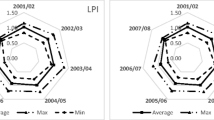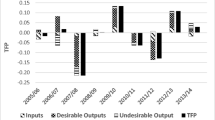Abstract
This paper aims to analyse the impact of regulation in the financial performance of the Water and Sewerage companies (WaSCs) in England and Wales over the period 1991–2008. In doing so, a panel index approach is applied across WaSCs over time to decompose unit-specific index number-based profitability growth as a function of the profitability, productivity and price performance growth achieved by benchmark firms, and the catch up to the benchmark firm achieved by less productive firms. The results indicated that after 2000 there is a steady decline in average price performance, while productivity improves resulting in a relatively stable economic profitability. It is suggested that the English and Welsh water regulator is now more focused on passing productivity benefits to consumers, and maintaining stable profitability than it was in earlier regulatory periods. This technique is of great interest for regulators to evaluate the effectiveness of regulation and companies to identify the determinants of profit change and improve future performance, even if sample sizes are limited.





Similar content being viewed by others
Notes
Spatially consistency implies that each year’s relative productivity measures do not depend on the other years in the comparison and temporal consistency implies that each firm’s productivity estimates do not depend on the number of observations in the time series.
While it would be particularly desirable to disaggregate other input usage data further and in particular to allow for separate energy and chemical usage inputs, the data available at company level from Ofwat’s regulatory return do not allow a further meaningful decomposition of other input sage.
The same firm is consistently found to have the highest spatial productivity estimates in all years, and is therefore modelled as the benchmark most productive firm in each year of our study.
References
Balk BM (2003) The residual: on monitoring and benchmarking firms, industries, and economies with respect to productivity. J Product Anal 20:5–47
Balk BM (2008) Price and quantity index numbers: models for measuring aggregate change and difference. Cambridge University Press, New York
Ball VE, Butault J-P, Nehring R (2001) U.S. agriculture, 1960–96, a multilateral comparison of total factor productivity. Electronic Report from the Economic Research Service, Technical Bulletin No. 1895, USDA: United States Department of Agriculture
Carvalho P, Marques RC (2014) Estimating size and scope economies in the portuguese water sector using the most appropriate functional form. Eng Econ (In Press)
Chang D-S, Yeh L-T, Liu W (2014) Incorporating the carbon footprint to measure industry context and energy consumption effect on environmental performance of business operations. Clean Technol Environ Policy (In press)
Coelli T, Walding S (2006) Performance measurement in the Australian water supply industry: a preliminary analysis. In: Ceolli T, Lawrence D (eds) Performance measurement and regulation of network utilities. Edward Elgar, Cheltenham
Coelli TJ, Rao DSP, O’Donnell CJ, Battese GE (2005) An introduction to efficiency and productivity analysis, 2nd edn. Springer, New York
Diewert WE (1999) Axiomatic and economic approaches to international comparisons. In: Eston R, Lipsey E (eds) International and interarea comparisons of income, output and prices. The University of Chicago Press, Chicago, pp 13–87
Diewert EW, Lawrence D (2006) Regulating electricity networks: the ABC of setting X in New Zealand. In: Coelli T, Lawrence D (eds) Performance measurement and regulation of network utilities. Edward Elgar, UK, pp 207–243
Elteto O, Koves P (1964) On a problem of index number computation relating to international comparisons. Stat Szle 42:507–518
Epure M, Kerstens K, Prior D (2011) Technology-based total factor productivity and benchmarking: new proposals and an application. Omega 39(6):608–619
Estache A, Trujillo L (2003) Efficiency effects of ‘privatization’ in Argentina’s water and sanitation services. Water Policy 5(4):369–380
Fox KJ, Grafton RQ, Kirkley J, Squires D (2003) Property rights in a fishery: regulatory change and performance. J Environ Econ Manag 46:156–177
Han S-H, Hughes AD (1999) Profit composition analysis: a technique for linking productivity measurement & financial performance. NSW Treasury Research & Information Paper, TRP 99-5. New South Wales: Office of Financial Management
Hill RJ (2002) Measuring price differences across space and time: the case of the European union’s harmonized index of consumer prices. Discussion Paper, School of Economics, The University of New South Wales
Hill RJ (2004) Constructing price indexes across space and time: the case of the European Union. Am Econ Rev 94(5):1379–1410
Lawrence D, Kain J (2012) The total factor productivity performance of Victoria’s gas distribution industry. Report prepared for Envestra Victoria, Multinet and SP AusNet
Lawrence D, Diewert WE, Fox KJ (2006) The contributions of productivity, price changes and firm size to profitability. J Prod Anal 26(1):1–13
Marques RC (2008) Comparing private and public performance of Portuguese water services. Water Policy 10(1):25–42
Marques RC, Simões P, Pires JS (2011) Performance benchmarking in utility regulation: the worldwide experience. Polish J Environ Stud 20(1):125–132
Maziotis A, Saal DS, Thanassoulis E (2009) Regulatory price performance, excess cost indexes and profitability: how effective is price cap regulation in the water industry? Aston Business School Working Papers, RP 0920. Aston University, Birmingham
Maziotis A, Saal DS, Thanassoulis E (2012) Output quality and sources of profit changes in the English and WelshWater and sewerage industry. FEEM working paper, Nota Di Lavoro, no. 85
Molinos-Senante M, Hernandez-Sancho F, Sala-Garrido R (2014a) Benchmarking in wastewater treatment plants: a tool to save operational costs. Clean Technol Environ Policy 16(1):149–161
Molinos-Senante M, Maziotis A, Sala-Garrido R (2014b) The Luenberger productivity indicator in the water industry: an empirical analysis for England and Wales. Util Policy 30:18–28
Ofwat (2006) July Returns for the Water Industry in England and Wales. CD-ROM. Office of Water Services, Birmingham
Pierani P (2009) Multilateral comparison of total factor productivity and convergence in Italian agriculture (1951–2002). DEPFID Working Papers—2, University of Sienna, Italy
Portela MCAS, Thanassoulis E, Horncastle A, Maugg T (2011) Productivity change in the water industry in England and Wales: application of the meta-malmquist index. J Oper Res Soc 62(12):2173–2188
Rao DSP, Banerjee KS (1984) A multilateral index number system based on the factorial approach. Stat Hefte 27:297–313
Rao DSP, O’Donnell CJ, Ball VE (2002) Transitive multilateral comparisons of agricultural output, input, and productivity: a nonparametric approach. In: Ball VE, Norton GW (eds) Agricultural productivity: measurement and sources of growth. Kluwer Academic Publishers, Norwell, pp 85–116
Saal D, Parker D (2001) Productivity and price performance in the privatized water and sewerage companies in England and Wales. J Regul Econ 20(1):61–90
Salerian J (2003) Analysing the performance of firms using a decomposable ideal index number to link profit, prices and productivity. Aust Econ Rev 2(36):143–155
Schuster M, Edelman DJ (2003) Latin American trends in urban environment. Clean Technol Environ Policy 5:50–60
Simões P, Marques RC (2012) Influence of regulation on the productivity of waste utilities. What can we learn with the Portuguese experience? Waste Manag 32(6):1266–1275
Szulc (Schultz) BJ (1964) Indices for multiregional comparisons. Prz Stat (Statistical Review) 3, 239–254
Waters WG, Tretheway MW (1999) Comparing total factor productivity and price performance: concepts and application to the Canadian railways. J Transp Econ Policy 33(2):209–220
Acknowledgments
The authors would like to express their gratitude for the support of the Economic and Social Science Research Council as well as the Office of Water Services (Ofwat). María Molinos-Senante would like to thank Generalitat Valenciana (APOSTD/2013/110) for financial support.
Author information
Authors and Affiliations
Corresponding author
Rights and permissions
About this article
Cite this article
Maziotis, A., Saal, D.S., Thanassoulis, E. et al. Profit, productivity and price performance changes in the water and sewerage industry: an empirical application for England and Wales. Clean Techn Environ Policy 17, 1005–1018 (2015). https://doi.org/10.1007/s10098-014-0852-2
Received:
Accepted:
Published:
Issue Date:
DOI: https://doi.org/10.1007/s10098-014-0852-2




